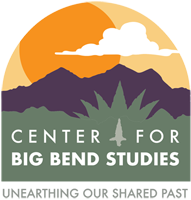Big Bend Sentinel October 22, 2024, story by Alexis Wolfe
ALPINE— Devin Pettigrew, who recalls his childhood habit of stalking squirrels in the woods in Arkansas, is now a visiting assistant professor at the Center for Big Bend Studies’ anthropology department at Sul Ross University. This fall, he teaches a course called Anthropology of Hunting, which investigates the origins of hunting and its impact on our evolutionary and cultural trajectories. Pettigrew’s research is in experimental archaeology, focusing on the tools and weapons of early hunter-gatherers, such as the atlatl.
The Sentinel sat down with Pettigrew to talk about his latest fieldwork, ancient weapons and the misconceptions of modern hunting.
Can you tell me when you first remember becoming fascinated with hunting? How did you end up where you are today?
I distinctly remember trying to stalk squirrels in the woods with a pocket knife lashed to a stick and a pair of moccasins I made in scout camp. I was probably 11 or 12. It was around that same time I killed my first deer. But as far back as I can remember, I’ve been fascinated with this kind of thing.
I attribute a lot of it to my dad because he was also fascinated by it. He wasn’t an archeologist, but he collected arrowheads as a boy from his farm. He introduced us to hunting and took us around to museums on family vacations.
At one point I think my folks were a little worried about me, like, “What’s gonna to happen to our weird child?” I was a super nerd. I had to know about this stuff. I studied online on atlatl forums and would basically research and write these long things about them on the forums. I had done enough research that I knew what these archaic artifacts looked like, and I wanted to replicate them precisely. For me, the Indigenous makers of these tools who were following along thousands of years of traditions were the people I wanted to learn from.
Are you currently conducting any fieldwork in the Big Bend region?
Over the summer, [Sul Ross] had a field school and worked at a nearby rock shelter. One of the rock shelters has the remains of an early archaic hunting kit, so we’re digging for those. We didn’t find any this summer, but last summer we found a 7,000-year-old atlatl as well as part of a hunting boomerang.
I’m also working on a project with archeologists who work in Mongolia. They’re finding arrow points and argali sheep skeletons at alpine sites, and I’m working with stuff they find. Here at the university, we’re trying to put together an experimental archeology lab that will include a ballistics component. Right now we need funding.
Can you tell me about the bison carcass experiments you’ve conducted across Colorado and Montana?
They’re exploratory experiments. There’s a lot you can do with the data, but basically, we get a bison, the rancher puts it down for us and then we experiment on it with Stone Age weapons. We record all of the ballistics data and then butcher it with stone tools.
We clean the bones and look at broken points and broken bones as well as ballistic impact data to learn about weapon efficiency. Right now I’m applying that to think about megafauna [animals weighing more than 100 pounds] and hunting potential, for the debate about why megafauna went extinct. That’s what I’m interested in.
A lot of your work revolves around the ancient weapon the atlatl. What did this weapon symbolize for our ancestors?
I can’t tell what it symbolized for people, right? That’s cosmology and belief and stuff. That’s really, really hard for archeologists to put back together. But it was a really important hunting tool.
For instance, in the Americas, we suspect that the earliest people to come into the continent had this weapon and that’s what they were hunting with primarily. It didn’t really get outpaced by the bow and arrow until about 2,000 years ago, even though there’s evidence that the bow and arrow started showing up in the northern part of the continent potentially 12,000 years ago.
This is the primary weapon used for the duration of prehistory here, and it definitely had symbolic and cosmological significance in Mesoamerican cultures.
Your work is imaginative in that it reaches tens of thousands of years into the past to tell us something about humans today. Do you think of hunting as an imaginative act?
Definitely. You have to be able to speculate and imagine and think about possibilities as a hominid hunter. There are theories that hunting, in part, is what creates modern cognition. Because you have to both store a bunch of information about things you’re hunting and also imagine possibilities.
So for instance, when the San [in Southern Africa] are hunting, they’re tracking animals, and when they lose tracks, they have to imagine themselves as the animal and think, “Where do I go now?” Before firearms, people would outfit themselves to look like the animals that they were hunting. They had to be very convincing at it, so they had to have all of the behaviors.
It goes so far that Native American hunters doing this had to go through all of the proper ritual channels before going on a hunt like that. When you’re putting on the deer outfit and going out and behaving like a deer, it’s so intense that you’re becoming a deer. You pass through this liminal period where you’re going from human to deer. And that’s the dangerous place to be, where you can get attacked spiritually, so you have to have protections in place.
So it was, in a way, an act of creativity?
Yeah. Another argument about hunting is that when you’re tracking, you’re storing knowledge about symbols, which creates the ability to recreate symbols in art. So, it’s part of what you show through rock art and stories, teaching people through an entertaining form of communication.
Do you believe that with the advancement of technology comes a loss in the intuitive connection to hunting our ancestors relied on in the past using simple weapons?
To some degree, yes. With pre-industrial hunting weapons, you have to be very close [to an animal]. Within 20 meters, preferably closer. That can require incredible skill and knowledge about how an animal is going to respond, to imagine where it’s going to be. How to act to convince them that you’re the animal, in the case that you’re using a disguise.
Nevertheless, modern hunters have to be knowledgeable about animal behavior. They aren’t always though, because a lot of times now it’s something that you do five days out of the year.
What do you think are the biggest misconceptions about hunting?
One is that it’s easy. There’s something called the Ecology of Fear, which is the study of anti-predator behaviors in prey animals. Prey animals aren’t stupid, and they can adapt to predation. So if you deploy a different type of weapon, they respond. The more predators there are, the bigger the response.
It’s not fair to say that we had these simple technologies and hunting was hard and it was fair for the animal, but now there are modern technologies and it’s not fair. That transition isn’t so simple, because these predator-prey relations change.
What are the ecological ramifications of hunting today?
Well, it’s used as a tool by wildlife managers to control wildlife populations. But the most dedicated hunters are conservation-minded. They want a healthy ecosystem because they want to be out experiencing it. [Modern hunting] faces a lot of negative public perception by people who, quite honestly, don’t fully understand it, because they haven’t done it, and they’re not willing to try.
The reality is that it’s used as a tool and it also creates a big impetus to keep wildlife on the landscape. The vast majority of hunters aren’t about the moment of killing something, because that’s not usually all that fun. But all the things surrounding it are.
Dr. Devin Pettigrew is giving a lecture on his latest bison experiment data — “Reconsidering Megafauna Hunting in the Pleistocene: State of the Debate and Insights from Experiments with the Atlatl and Dart” — on December 5 at the Warnock Science Building for the Science Seminar Series at Sul Ross University. All are welcome.
Pettigrew mentioned that he set his Anthropology of Hunting course to begin at 5 p.m. in anticipation of more auditors registering for the course. Non-students are permitted to audit up to two courses per semester at Sul Ross University. The cost to audit a course is $50 per semester.


